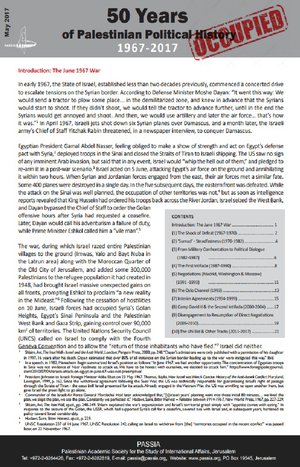50 Years of Palestinian Political History 1967-2017
Overview
The June 1967 War:
In early 1967, the State of Israel, established less than two decades previously, commenced a concerted drive to escalate tensions on the Syrian border. According to Defense Minister Moshe Dayan: “It went this way: We would send a tractor to plow some place... in the demilitarized zone, and knew in advance that the Syrians would start to shoot. If they didn’t shoot, we would tell the tractor to advance further, until in the end the Syrians would get annoyed and shoot. And then, we would use artillery and later the air force… that’s how it was.”1
In April 1967, Israeli jets shot down six Syrian planes over Damascus, and a month later, the Israeli army’s Chief of Staff Yitzhak Rabin threatened, in a newspaper interview, to conquer Damascus. Egyptian President Gamal Abdel Nasser, feeling obliged to make a show of strength and act on Egypt’s defense pact with Syria,2 deployed troops in the Sinai and closed the Straits of Tiran to Israeli shipping. The US saw no sign of any imminent Arab invasion, but said that in any event, Israel would “whip the hell out of them,” and pledged to re-arm it in a post-war scenario.3 Israel acted on 5 June, attacking Egypt’s air force on the ground and annihilating it within two hours. When Syrian and Jordanian forces engaged from the east, their air forces met a similar fate. Some 400 planes were destroyed in a single day. In the five subsequent days, the eastern front was defeated. While the attack on the Sinai was well planned, the occupation of other territories was not,4 but as soon as intelligence reports revealed that King Hussein had ordered his troops back across the River Jordan, Israel seized the West Bank, and Dayan bypassed the Chief of Staff to order the Golan offensive hours after Syria had requested a ceasefire. Later, Dayan would call his adventurism a failure of duty, while Prime Minister Eshkol called him a “vile man”.5 The war, during which Israel razed entire Palestinian villages to the ground (Imwas, Yalo and Bayt Nuba in the Latrun area) along with the Moroccan Quarter of the Old City of Jerusalem, and added some 300,000 Palestinians to the refugee population it had created in 1948, had brought Israel massive unexpected gains on all fronts, prompting Eshkol to proclaim “a new reality in the Mideast.”6 Following the cessation of hostilities on 10 June, Israeli forces had occupied Syria’s Golan Heights, Egypt’s Sinai Peninsula and the Palestinian West Bank and Gaza Strip, gaining control over 90,000 km2 of territories. The United Nations Security Council (UNCS) called on Israel to comply with the Fourth Geneva Convention and to allow the “return of those inhabitants who have fled.”7 Israel did neither.

